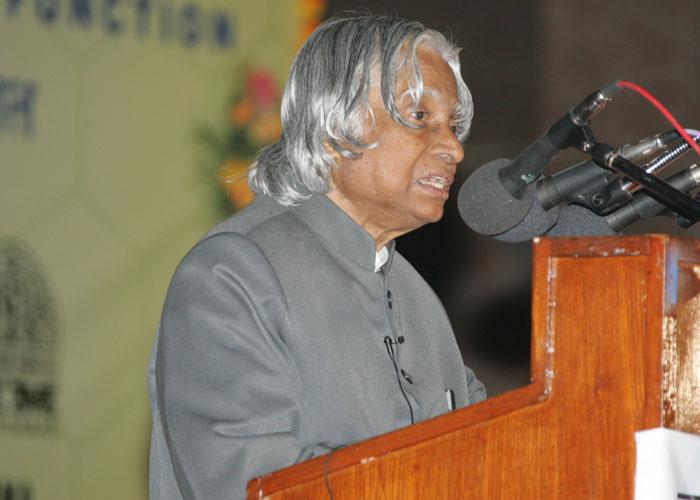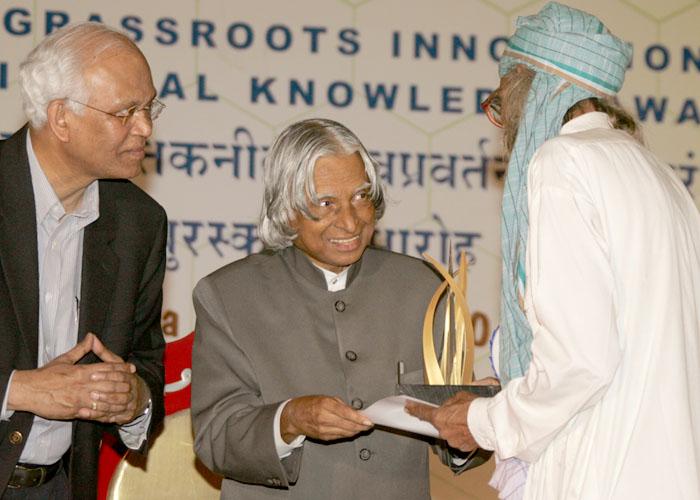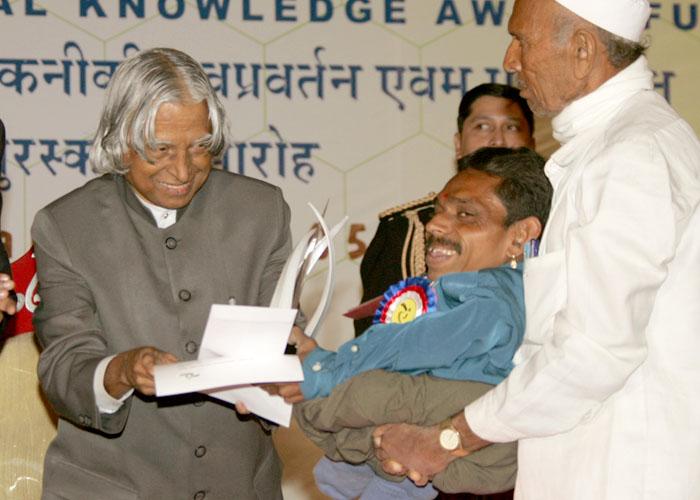Address a the Presentation of 3rd Annual Award Distribution Function of National Innovation Foundation, Ahmedabad
Ahmedabad : 05-01-2005
Innovations and its Dimensions
I am indeed delighted to participate in the 3rd National Award Function of the National Innovation Foundation. I greet the award winners, innovators, collaborators and the organizers and the National Innovation Foundation (NIF). The objectives of NIF to help India become an innovative and creative society and a global leader in sustainable technologies by scouting, spawning and sustaining grassroots innovations. is indeed a laudable effort. Grassroots does not mean living with old unproductive small time mindsets. Cobbler as a cobbler, fishermen in the same old boat with few nuts changed but to move fast towards knowledge society.
Innovation is the capital
I was studying the Global Competitiveness Report for the year 2003-04. There I find in terms of Innovative Capacity Index US is ranked one, Singapore 6, South Africa 27, China 40, Brazil 42 and India 44. In the same report I noticed that the proportion of Scientists and Engineers Index is stated as US 4, Singapore 6, South Africa 38, China 43, Brazil 51 and India 60. Thus, we can see the large proportion of new ideas and innovation are generated in the Universities in USA. This innovation arises from private sector initiative and the R & D productivity of the firm, shape by local policies and nature of local institutions. National innovative capacity has to be the country's important potential to reinforce both political and economic entity with commercially relevant competitive products. This capacity is distinct from purely scientific or technical achievements and focuses on the economic application of new technology. Thus, for building innovative capacity, we require the partnership of private sector, public sector, R & D and academia as a group. I would recommend the Hyderabad University to work towards building the innovative capacity amongst its faculty and impart knowledge with students.
To achieve a goal what is needed is not only knowledge, but also a passion. The passion should not be limited to the technical aspects but it should also aim towards creating a concern for the society with a view to finding positive solutions to the problems.
Team building
In the present day world when the corpus of known knowledge is multi-disciplinary and products and services are complex it is often not possible to have a loner as an innovator. Most of the discoveries and innovation are team efforts. Education system should work towards team building among the students. Every student must have an opportunity to play the role of a team member and a team leader so that he can see both sides of the fence. The amount of information that we have around us is overwhelming. The management of knowledge therefore must move out of the realm of the individual and shift into the realm of the networked groups. The students must learn how to manage knowledge collectively. When the information is networked the power and utility of the information grows as squared as predicted by Metcalfe's law. Information that is static does not grow. In the new digital economy, information that is circulated creates innovation and contributes to national wealth. In this context, let us discuss the national scenario and its priorities.
Young Innovators
The creativity is indeed the result of the education process and the environment of the school and above all the teacherscapability in igniting the minds of the students. The essence of it can be seen in the following verses:
Learning gives creativity
Creativity leads to thinking,
Thinking provides knowledge
Knowledge makes you great.
I would like to share with this audience, about the six young innovators from various schools of our country whom I met at Rashtrapati Bhavan on 2nd September 2004.
Their innovations were:- a system to prevent the soiling of railway tracks by Madhav Pathak of Jabalpur, Madhya Pradesh, herbal pesticide tablets for storage of food grains by Priyanka Guleria of Sionty Village in Punjab, low calorie biscuits made from banana peels by Rucha Joshi of Nanded, Maharashtra, a toy lazer for educational applications by Sudhanwa Hukkeri of Belgaum, Karnataka, a software programme for embedding of text through audio signals by Kyan Pardiwalla of Mumbai, Maharashtra and an optically controlled wheel chair by S. Harish Chandra of Chennai, Tamil Nadu.
The group was chosen following a rigorous selection process and the innovations had the largest number of footfalls at the Tokyo Exhibition. The process of selection and sending the group abroad was co-ordinated by Confederation of Indian Industries (CII) and the Department of Science and Technology (DST).
Creativity
Since our population is of a billion people, the society in its own way has to make innovations continuously, not only in urban areas but also in rural areas. For example, the honey bee network movement is an excellent attempt.Creativity comes from beautiful minds. It can be anywhere and any part of the country. It may start from a fisherman hamlet or a farmer's household or a dairy farm or cattle breeding centre or it emanates from class rooms or labs or industries or R&D centres. Creativity has got multi dimensions like inventions, discoveries and innovations. Creativity has got an ability to imagine or invent something new by combining, changing or reapplying existing ideas. Creativity has an attitude to accept change and newness, a willingness to play with ideas and possibilities, a flexibility of outlook, the habit of enjoying the good, while looking for ways to improve it. Creativity has a process to work hard and continually to improve ideas and solutions by making gradual alterations and refinements to their works. The important aspect of creativity is: seeing the same thing as everybody else, but thinking of something different.
Innovation
Innovation is market driven. Innovation can also be making improved performance of the product/system technique by adopting a change using most alternative technologies. An innovative product makes a leap in the benefits-to-costs ratio ion some area of endeavour. Innovation is a systematic, organized, rational work usually done in many stages like analysis, tests, experiment etc. I would like to give a few examples of innovative technologies/applications. What we see in optical communications is speed vs cost. In flexible manufacturing systems it is choice vs cost. In the web-enabled processes, it is customer satisfaction vs cost. Again in e-Mail, a message is instantly delivered in any part of the world through internet.
Building Innovation System
It is through the process of innovation that knowledge is converted into wealth and social good. Further, innovation is an important factor for the competitiveness of both service and manufacturing sectors. Innovation tends to emanate less from R&D and more from other sources, including organizational change. Hence there is an urgent need to establish an efficient innovation system in the country. Such a system would involve creation of clusters, which are networks of inter-dependent firms, knowledge producing institutions (universities, colleges/institutes, research institutes, technology providing firms), bridging institutions (e.g. think tanks, providers of technical or consultancy services) and customers linked in a value-addition creating production chain. The concept of clusters goes beyond that of a firm network, as it captures all forms of knowledge sharing and exchange. Thus an innovative system with its clusters would tap into the growing stock of global knowledge, assimilate and adapt it to local needs and finally create new knowledge and technology.
Partnership
The National Innovation Foundation is able to attract number of innovations coming from the rural sector. However, what they need is design input to make it into a competitive marketable product. I would recommend a collaborative venture between the National Institute of Design and National Innovation Foundation to work on converting the promising innovations into a commercially viable venture. This can lead to creation of a number of enterprises in the rural sector leading to large scale employment opportunity and wealth generation in the rural areas. The establishment of enterprises for such ventures can be financially supported by the Technology Development Board which is part of the Department of Science and Technology.
Conclusion
Innovation at the rural area: Search and locate any ambient innovations competencies, recognize promising innovations and assist through Self Help Groups. As a next stage systematic design of the innovation can be supported by institutions like NID transforming it into a business proposition. At this stage banks should provide venture capital. Once the production stabilizes in small scale it can be extended to large commercial production through the assistance of Technology Development Board. These enterprises should preferably be located in the rural sector where the raw material and the inputs will be available. Also there is a need to train the local youth for undertaking the production and marketing operation. My best wishes to all members of the National Innovation Foundation and rural innovators for their productive contribution in the mission of rural development.
May God Bless You.



